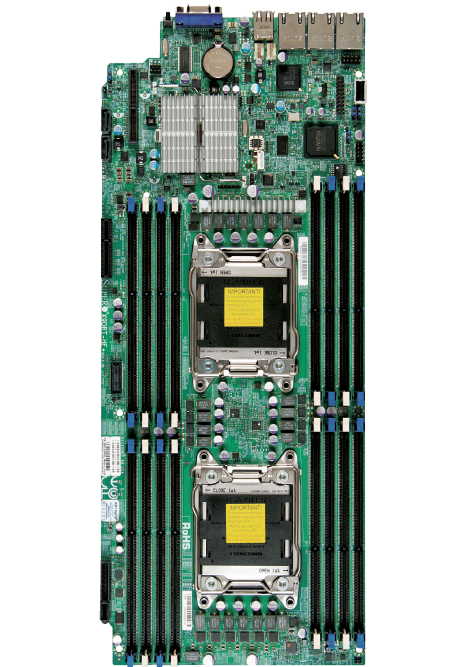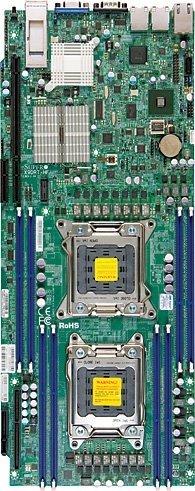LRDIMMs, RDIMMs, and Supermicro's Latest Twin
by Johan De Gelas on August 3, 2012 4:45 AM EST- Posted in
- IT Computing
- Intel
- Samsung
- Xeon
- Cloud Computing
- Supermicro
Supermicro's 2U Twin
We already introduced Supermicro's Twin 2U server (6027TR-D71FRF) in our Xeon E5 review. It is basically a two node 2U server that offers the density of 1U servers without the disadvantages. Instead of four redundant PSUs you only need two, and instead of noisy, energy hogging and prone to break 40mm fans you get slower turning 80mm fans.
The two servers are held in place using screwless clips.
There was one big disadvantage: there were only four DIMM slots per CPU, which limits each node to 128GB of RAM (8 x 16GB). That is a bit on the low side for 16 cores and 32 threads and makes this server less suitable for virtualization loads.
Of course, this server was never meant to be a virtualization server as it is equipped with 56Gb/s TFDR InfiniBand interconnect technology, great for processing intensive cluster applications like some clustered HPC apps. Nevertheless, we were intrigued. Supermicro has recently released a new Twin, the 6027TR-D70RF+, which has 16 DIMM slots.

Most 2U servers are limited to 24 memory slots and as a result 384GB of RAM. With two nodes in a 2U server and 16 slots per node, you get cram up to 512GB of RDIMMs in one server. The Supermicro Twin node (6027TR-D70RF+) looks like an attractive alternative for the more common 1U and 2U servers:
- Much more (3, 2 full height) PCIe expansion slots than a 1U, almost as good as a traditional 2U
- Lower energy consumption as two (up to 95% efficient) PSUs are powering two nodes
- Much better and more efficient 80mm cooling fans than a 1U
- Density of a 1U
- 33% more DIMM slots than a 2U
That all sounds great for any cluster solution including a virtualization cluster, but there is more. If you use LRDIMMs, you can double your capacity. LRDIMMs at 1333MHz are available as quad rank 32GB DIMMs. But before we can introduce you to these DIMMs, we want to take a step back and look at all the RAM options that a typical server buyers has.












26 Comments
View All Comments
koinkoin - Friday, August 3, 2012 - link
For HPC solutions I like the Dell C6220, dense, and with 2 or 4GB of memory per cpu core you get a good configuration in a 2U chassis for 4 servers.But for VMware, servers like the R720 give you more room to play with memory and IO slots.
Not counting that those dense server don’t offer the same level of management and user friendliness.
JohanAnandtech - Friday, August 3, 2012 - link
A few thoughts:1. Do you still need lots of I/O slots now that we can consolidate a lot of gigabit Ethernets in Two 10GBe
2. Management: ok, a typical blade server can offer a bit more, but the typical remote management solutions that Supermicro now offers are not bad at all. We have been using them for several years now.
Can you elaborate what you expect from the management solution that you won't expect to see in a dense server?
alpha754293 - Friday, August 3, 2012 - link
re: network consolidationNetwork consolidation comes at a cost premium. You can still argue that an IB QDR will give you better performance/bandwith, but a switch is $6k and other systems that don't have IB QDR built in, it's about $1k per NIC. Cables are at least $100 a piece.
If you can use it and justify the cost, sure. But GbE is cheap. REALLY REALLY cheap now that it's been in the consumer space for quite some time.
And there aren't too many cases when you might exceed GbE (even the Ansys guys suggest investing in better hardware rather than expensive interconnects). And that says a LOT.
re: management
I've never tried Supermicro's IMPI, but it looks to be pretty decent. Even if that doesn't work, you can also use 3rd party like logmein and that works quite well too! (Although not available for Linux, but there are Linux/UNIX options available out there as well).
Supermicro also has an even higher density version of this server (4x half-width, 1U DP blade node.)
JonBendtsen - Monday, August 6, 2012 - link
I have tried Supermicro IPMI, works nicely. I can power on/off the machine and let it boot from a .iso image I have on my laptop. This means that in case I have to boot from a rescue CD, then I do not even have to plug a CD drive into the machine. Everything can be done from my laptop, even when I am not in the office, or even the country.bobbozzo - Tuesday, August 7, 2012 - link
Can you access boot screens and the BIOS from the IPMI?For Linux, I use SSH (or VNC server), but when you've got memory or disk errors, etc., it's nice to see the BIOS screens.
Bob
phoenix_rizzen - Thursday, August 9, 2012 - link
Using either the web interface on the IPMI chip itself, or the IPMIView software from SuperMicro, you get full keyboard, mouse, console redirection. Meaning, you can view the POST, BIOS, pre-boot, boot, and console of the system.You can also configure the system to use a serial console, and configure the installed OS to use a serial console, and then connect to the serial console remotely using the ipmitool program.
The IPMI implementation in SuperMicro motherboards (at least the H8DG6/H8DGi series, which we use) is very nice. And stable. And useful. :)
ForeverAlone - Friday, August 3, 2012 - link
Only 128GB RAM? Unacceptable!Guspaz - Monday, August 20, 2012 - link
It starts to matter more when you're pouring on the VMs. With two sockets there, you're talking 16 cores, or 32 threads. That's the kind of machine that can handle a rather large number of VMs, and with only 128GB of RAM, that would be the limitation regarding how many VMs you could stick on there. For example, if you wanted to have a dedicated thread per VM, you're down to only 4GB per VM, which is kind of low for a server.darking - Friday, August 3, 2012 - link
I think the price on the webpage is wrong. or atleast it differs by market.i just checked the Danish and the British webstores, and the 32GB LRDIMMS are priced at around 2200$ not the 3800$ that the US webpage has.
JohanAnandtech - Friday, August 3, 2012 - link
They probably changed it in the last few days as HP as lowered their price to $2000 a while ago. But when I checked, it was $3800